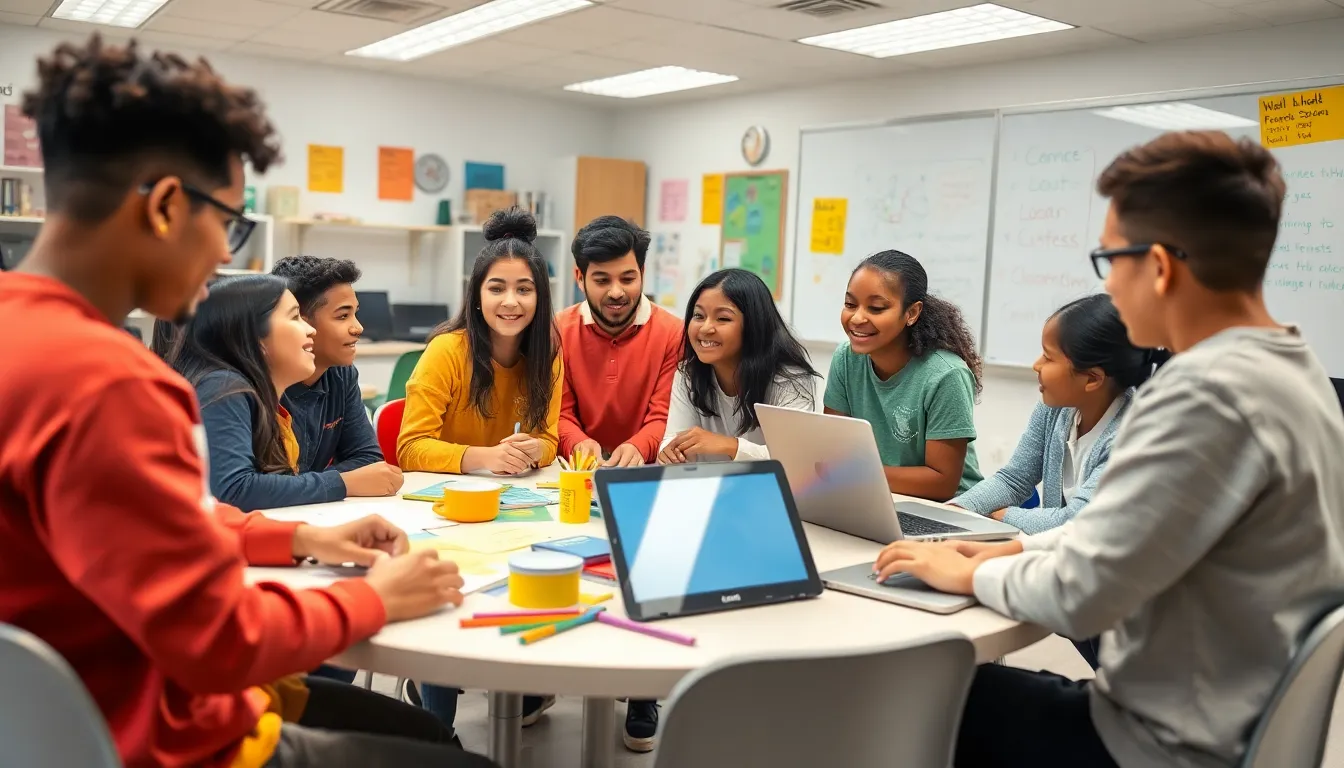In today’s fast-paced world, education isn’t just about textbooks and tests; it’s a battleground of ideas, innovation, and the occasional awkward group project. With technology evolving faster than a caffeinated squirrel, schools are scrambling to keep up, and students are feeling the heat. From the digital divide to mental health challenges, the issues are as diverse as the students themselves.
But don’t worry, it’s not all doom and gloom! This is the perfect moment to shake things up and rethink how education can evolve. Whether it’s finding new ways to engage learners or addressing systemic inequalities, there’s plenty to discuss. Buckle up as we dive into the pressing education issues of today—because who said learning can’t be a little entertaining?
Table of Contents
ToggleOverview Of Education Issues Today
Education today faces numerous challenges that significantly impact students and educators. Technological advancements create both opportunities and obstacles, requiring schools to adapt swiftly to new tools and platforms. The digital divide remains a critical issue, with students in low-income areas lacking access to essential technology and reliable internet.
Mental health issues among students have surged, influencing academic performance and overall well-being. Schools often struggle to provide adequate support and resources to address these needs. Systemic inequalities also plague the education system, disproportionately affecting marginalized communities. Addressing these disparities requires targeted policies and investment.
Curriculum relevancy poses another pressing concern. Many educational programs do not align with the skills demanded by today’s job market. Students benefit from project-based learning that prepares them for real-world challenges.
Teacher retention remains a significant issue. High workloads and insufficient pay lead many educators to leave the profession early. Fostering a supportive work environment can help retain experienced teachers.
Furthermore, accountability measures often emphasize standardized testing, which can narrow the curriculum and limit creative teaching approaches. Shift towards comprehensive assessments that prioritize critical thinking and problem-solving skills could enhance learning outcomes.
In tackling these prevalent education issues, it’s essential for policymakers, educators, and communities to collaborate. Innovative solutions and a commitment to equity can cultivate an inclusive and effective educational environment for all students.
Key Challenges Facing Education Today

Education today faces multiple key challenges that inhibit effective learning and equitable access. The issues of funding disparities, teacher shortages, and curriculum relevance stand out prominently.
Funding Disparities
Funding disparities directly impact the quality of education across various school districts. Wealthy districts often enjoy ample resources, while low-income districts struggle to provide basic facilities. According to the National Center for Education Statistics, schools in high-poverty areas receive about 25 percent less funding per student compared to their affluent counterparts. Consequently, this affects access to technology, extracurricular activities, and advanced courses. Schools with less funding frequently lack trained staff and up-to-date materials. Students in underfunded schools face significant hurdles, limiting their educational opportunities and future success.
Teacher Shortages
Teacher shortages increasingly challenge educational institutions at all levels. High turnover rates contribute to this ongoing crisis, stemming from inadequate pay and overwhelming workloads. Studies indicate that almost 50 percent of new teachers leave the profession within five years due to these pressures. As a result, many classrooms lack experienced educators, negatively impacting student learning experiences. Furthermore, the ongoing demand for qualified teachers exacerbates this issue, particularly in STEM areas and special education. Ensuring competitive compensation and creating a supportive work environment can help retain teachers and improve educational outcomes.
Curriculum Relevance
Curriculum relevance remains a crucial challenge in modern education. Many existing programs fail to equip students with skills essential for today’s job market. Research shows that over 60 percent of employers find recent graduates lacking in practical skills and critical thinking. Project-based learning offers solutions, allowing students to engage in real-world applications and develop problem-solving skills. Schools must prioritize updating curricula to align with evolving industry demands and technological advancements. Doing so enhances student engagement while ensuring graduates are better prepared for future careers.
The Impact Of Technology On Education
Technology profoundly influences education, reshaping how teachers educate and students learn. Online learning tools expand access, allowing students to participate in classes from anywhere.
Online Learning Environment
The online learning environment offers flexibility and convenience. Students often engage with interactive resources like videos and quizzes, promoting deeper understanding. Instructors utilize platforms to provide instant feedback, enhancing student performance. It’s essential to create a sense of community in these environments to combat feelings of isolation. Many institutions invest in virtual discussion boards and group projects to foster collaboration.
Digital Divide
The digital divide presents a significant challenge in education. Many low-income families lack access to reliable internet and devices, limiting educational opportunities. Approximately 14 million students face barriers due to this divide, hindering their academic progress. Schools are increasingly addressing this issue by providing devices and internet access. Partnerships with local governments and organizations can bridge gaps, ensuring equitable access to technology. The emphasis on addressing these disparities remains critical in promoting inclusivity in education.
Social And Emotional Learning
Social and emotional learning (SEL) plays a critical role in addressing the diverse needs of students today. Incorporating SEL into education nurtures skills like self-awareness, emotional regulation, and interpersonal relationships that are essential for academic and personal success.
Importance Of Mental Health Support
Mental health support in schools holds immense significance. Approximately 1 in 5 students experiences mental health challenges, impacting their academic performance and overall well-being. Providing resources such as counseling services allows students to seek help and build resilience against stressors. Training teachers to recognize mental health signs fosters a supportive environment. Prioritizing mental health initiatives can lead to improved attendance, higher graduation rates, and healthier school cultures.
Addressing Bullying And Inclusivity
Addressing bullying and promoting inclusivity enhances student safety and well-being. Nearly 20% of students report being bullied at school, which can create a hostile learning environment. Implementing anti-bullying programs cultivates a culture of respect and empathy among students. Emphasizing inclusivity ensures that all students, regardless of background, feel valued and accepted. Encouraging diverse perspectives in classroom discussions enhances social awareness and fosters a sense of belonging, leading to enriched educational experiences.
Policy Changes And Innovations
Education reform requires strategic policy changes and innovative practices to address current challenges. Both governmental roles and community engagement significantly influence these efforts.
Role Of Government In Education Reform
Government plays a pivotal role in shaping educational policies that directly impact students. Funding allocations often determine resource availability, which can create disparities between affluent and underfunded districts. Legislative changes can promote equity by addressing those funding gaps, leading to improved access for all students. Policy frameworks must focus on inclusivity and adaptability to emerging educational needs. Furthermore, accountability measures should ensure that schools meet standards, fostering a culture of excellence among educators and students alike.
Community Involvement And Advocacy
Community involvement drives effective educational reform by creating a collaborative framework. Local organizations and advocacy groups often mobilize resources to support schools and students. Parents, caregivers, and community members can contribute by voicing their needs and concerns, ensuring that educational policies reflect their realities. Active participation in school boards and committees encourages transparency and accountability. Partnerships between schools and community entities enhance programs that address specific challenges, such as mental health support and technology access, ultimately benefiting all students.
Addressing today’s education issues requires a collective effort from all stakeholders. By embracing innovation and prioritizing inclusivity schools can create environments that foster engagement and support for every student.
It’s essential to recognize the impact of technology and mental health on learning experiences. Equipping educators with the necessary resources and support can lead to improved outcomes for students.
Collaboration among policymakers educators and communities is crucial in driving meaningful change. Together they can work towards a more equitable education system that prepares students for the challenges of the future.



